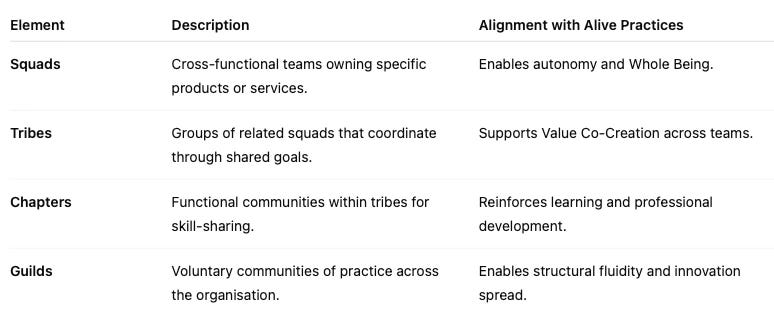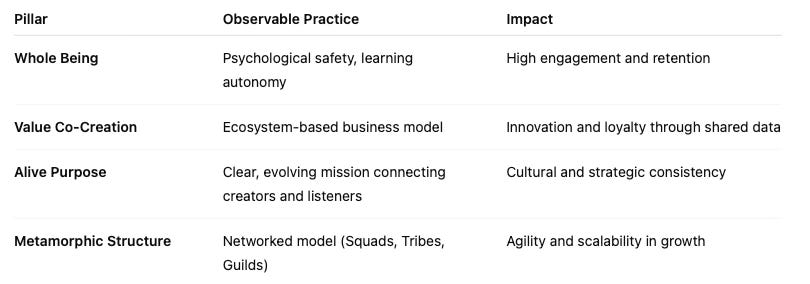Context and Overview
Founded in 2006 in Stockholm, Spotify redefined how the world accesses and experiences music. With over 600 million active users and operations in more than 180 markets, it operates at global scale yet maintains a culture of experimentation and agility that continues to attract study and imitation.
Spotify’s structure and practices reflect many features of an Alive Organisation: a system built for learning, co-creation, and adaptation rather than rigid control.
Its evolution demonstrates how the four pillars of aliveness — Whole Being, Value Co-Creation, Alive Purpose, and Metamorphic Structure — can function coherently in a digital ecosystem.
1. Whole Being – Supporting Human Autonomy and Development
Spotify’s early leadership recognised that creativity and innovation depend on psychological safety and autonomy.
Its people model is built on three core assumptions:
People want to do great work.
Alignment is better than control.
Growth depends on learning, not permission.
Key practices include:
Squad Autonomy: Small, cross-functional teams own end-to-end delivery for specific features or services.
Personal Development Frameworks: Employees define growth goals in collaboration with managers, supported by learning stipends and internal academies.
Feedback Culture: Regular retrospectives and open peer feedback reinforce continuous learning.
Health Checks: Teams run self-assessments on trust, collaboration, and morale, identifying issues before they impact delivery.
These practices align with the People-Related Practices pillar, ensuring individuals feel ownership and psychological safety — two foundations of aliveness at work.
2. Value Co-Creation – Building Networks of Shared Learning
Spotify’s value creation model is built on co-creation between artists, listeners, advertisers, and developers. Rather than seeing itself as a simple streaming provider, Spotify acts as an ecosystem orchestrator, enabling multiple stakeholders to generate and share value.
Examples include:
Artist Tools (Spotify for Artists): Provides analytics and insights that help creators make data-informed artistic and commercial decisions.
User Feedback Loops: Real-time user data fuels product evolution — playlists, discovery features, and interface improvements are shaped by actual behaviour and feedback.
Collaborative Playlists and Community Engagement: Users become co-curators, creating and sharing music experiences collectively.
Partner Integrations: Spotify connects with automotive, telecom, and device partners (e.g., Tesla, Samsung, Vodafone), embedding music as a feature of broader digital ecosystems.
This multi-directional flow of information and value represents the essence of Value Co-Creation Practices — shared innovation based on transparency and mutual learning.
3. Alive Purpose – Evolving the “Why”
Spotify’s stated mission — “to unlock the potential of human creativity by giving a million creative artists the opportunity to live off their art and billions of fans the opportunity to enjoy and be inspired by it” — serves as a Superior Purpose in the Alive framework.
This purpose operates on multiple levels:
For artists, it provides income and visibility.
For listeners, it provides inspiration and connection.
For society, it promotes access to culture and diversity.
Spotify’s strategic choices consistently trace back to this purpose. Examples:
The launch of the Spotify Creator Equity Fund, aimed at supporting underrepresented creators.
Ongoing investments in AI-powered personalisation to ensure that user experiences remain inclusive and relevant.
Strategic Foresight practices in content, regulation, and culture that help Spotify anticipate changes in the creative economy, from licensing models to generative AI and creator monetisation.
By treating purpose as an evolving management principle — not a fixed statement — Spotify maintains clarity of direction in a highly volatile market.
4. Metamorphic Structure – Scaling Agility
Spotify’s structure is one of the most frequently studied organisational models of the digital age. While often oversimplified externally as the “Spotify Model,” internally it represents a living, adaptive structure that continues to evolve.
Key elements include:
Spotify uses lightweight governance mechanisms — alignment through purpose and context rather than command. Leadership sets direction; squads decide how to achieve it. Structural evolution is continuous — elements are reviewed regularly for relevance and redefined as strategy evolves.
Agentic AI systems are now integrated in internal processes, supporting:
Performance insight (team health, delivery patterns).
Strategic foresight (trend identification in listening behaviour).
Predictive analytics (capacity and resource planning).
These AI capabilities act as augmentation tools, enabling leadership to identify emerging opportunities or bottlenecks early — reinforcing the Metamorphic Structure principle of continuous learning and adaptation.
Governance and Decision Flow
Spotify balances autonomy with alignment through a governance model focused on clarity, context, and accountability:
Alignment over Control: Strategy is cascaded through context-sharing, not detailed directives.
Decision Ownership: Teams make product decisions; leaders focus on setting clear boundaries and priorities.
Feedback Loops: Regular “bet reviews” assess whether strategic bets still align with user needs and purpose.
Data Transparency: Access to live dashboards and metrics supports real-time decisions across teams.
This model maintains coherence without centralised micromanagement — a key hallmark of an adaptive enterprise.
Systemic Integration
Spotify’s aliveness stems from coherence across all four pillars:
This internal alignment allows Spotify to renew its business model continuously while preserving its cultural identity.
Lessons for Other Organisations
Spotify demonstrates that aliveness at scale requires three interconnected capabilities:
Cultural Infrastructure: strong values, transparent communication, and continuous learning.
Structural Flexibility: modular teams and adaptable governance models.
Purpose Consistency: clarity of direction, supported by foresight and ethical use of AI.
These principles can be applied across industries — provided leadership commits to learning as a strategic asset and empowers teams to act with autonomy within purpose-driven boundaries.
Conclusion
Spotify operates as a living system — adaptive, purpose-led, and resilient.
Its organisational model shows that scale and aliveness are not contradictory; they depend on each other.
By combining human creativity with structured autonomy and intelligent technology, Spotify continues to evolve faster than its environment — a practical example of Metamorphic Design and Systemic Aliveness in action.
Enjoy reading and applying these materials. If you’d like to receive additional information regarding Alive Organisations topic please subscribe below.



